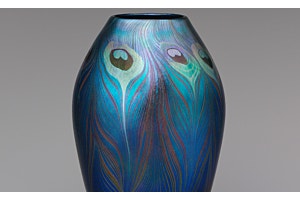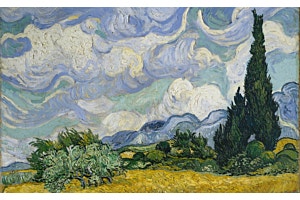
Louis Comfort Tiffany at The Met
A fascination with luminosity prompted Louis Comfort Tiffany’s (American, 1848–1933) foray into the world of electric lighting around the turn of the 20th century. Acclaimed for his kaleidoscopic stained-glass windows brought to life with natural light, the Gilded Age visionary adapted his methods to the production of lamps with leaded-glass shades. Here, we share a few of our favorite lampshade designs in the Museum's American Wing, which have been reimagined as Met Store accessories.
Gifts for Art Lovers
With their sunny petals and trumpet-like forms, daffodils are joyous harbingers of spring. For their resilience as one of the early-blooming flowers of the season, they’re celebrated the world over as symbols of hope and rebirth. The cheery florets defining our new Gilded Age Daffodil Jewelry are plucked from the “Daffodil” lamp produced by Tiffany Studios (American, 1902–32) around 1904–10. These radiant enamel adornments will add a spring to your step—and your look—as winter thankfully thaws.




The daffodil appears to have been a popular Tiffany Studios subject over several decades. Archival photographs of the studio show real daffodils arranged on model shades, demonstrating how closely the artisans worked from nature.


While the initial designs for Tiffany Studios lamps came from Louis C. Tiffany, essential artistry was provided by the fleet of women known as the "Tiffany Girls," who selected and cut the individual glass pieces so that each model showcased unique variations. This particular lampshade, with its subtle yellow hues, reflects the remarkable sensitivity of the artisan who assembled it.


The wonderfully jewel-toned “Tulip” lamp (1907–12) serves as the inspiration behind our Favrile Tulip Enamel Jewelry.




This particular model in the Museum’s holdings exhibits some of the richest colorations of glass, which vary from pink to red and purple.


The rich hues and pillowy petals of the peonies decorating a floor lamp designed in 1904–15 inform our head-turning Louis C. Tiffany Peonies Silk Neckerchief.


The size and shape of the individual pieces of glass on the Museum’s elaborate lampshade mimic the actual petals and leaves of the flower itself.


This fanciful bookmark recalls a watercolor study (ca. 1905) for a “Dragonfly” lampshade, which was a popular Tiffany Studios design.


This particular sketch belongs to a rare double watercolor study, showcasing how Louis C. Tiffany would modify a single design in different colorways for his clients. The two studies are nearly identical, with one in a primarily green palette and the other in light blue with a brown border.


Museum Gift Shop
Shop jewelry, scarves, and other artful accessories inspired by the designs of Louis C. Tiffany in-store at The Met Fifth Avenue and online.
* Image © The Metropolitan Museum of Art.







